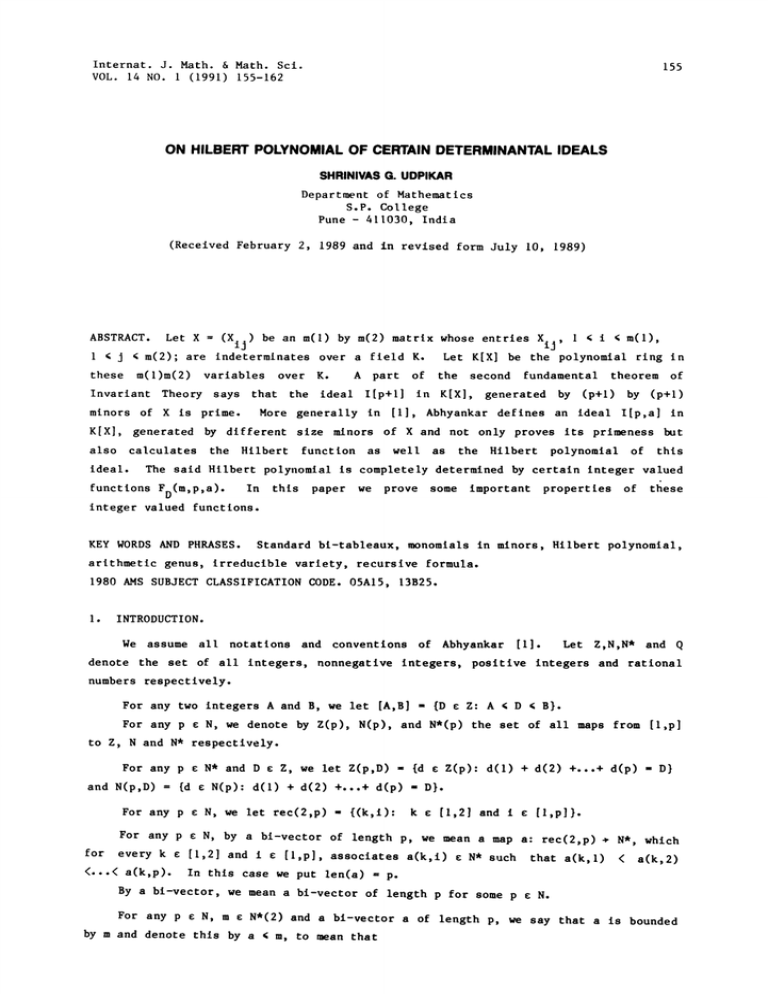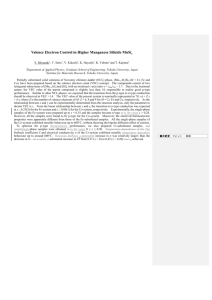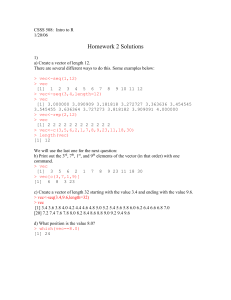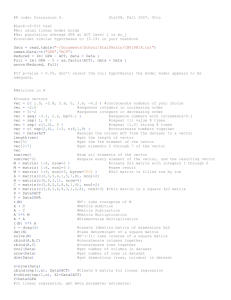HILBEFIT POLYNOMIAL OF DETERMINANTAL
advertisement

Internat. J. Math. & Math. Sci.
VOL. 14 NO.
(1991) 155-162
155
ON HILBEFIT POLYNOMIAL OF CERTAIN DETERMINANTAL IDEALS
SHRINIVAS G. UDPIKAR
Department of Mathematics
Pune
S.P. College
411030, India
(Received February 2, 1989 and in revised form July I0, 1989)
be an m(1) by m(2) matrix whose entries
Let X
Xij, < i < m(1),
are
K.
m(2);
Indeterminates
field
j
Let K[X] be the polynomial ring in
over a
these m(1)m(2) variables over K.
A part of the second fundamental theorem of
Invariant Theory says that the ideal I[p+l] in K[X], generated by (p+l) by (p+l)
minors of X is prime.
More generally in [I], Abhyankar defines an ideal lip,el in
K[X], generated by different size minors of X and not only proves its primeness but
ABSTRACT.
(Xij)
calculates
also
ideal.
the
Hilbert
function
as
well
as
the Hilbert
polynomial
of
this
The said Hilbert polynomial is completely determined by certain integer valued
functions
FD(m,p,a).
In this paper we prove some important properties of
tese
integer valued functions.
KEY WORDS AND PHRASES.
Standard bl-tableaux, monomlals in minors, Hilbert polynomial,
arithmetic genus, irreducible variety, recursive formula.
1980 AMS SUBJECT CLASSIFICATION CODE. 05A15, 13B25.
1.
INTRODUCTION.
We assume all notations and conventions of Abhyankar
[I].
Let Z,N,N* and Q
denote the set of all integers, nonnegative integers, positive integers and rational
numbers respectively.
For any two integers A and B, we let [A,B]
Z: A < D < B}.
{D
For any p
N, we denote by Z(p), N(p), and N*(p) the set of all maps from if,p]
to Z, N and N* respectively.
For any p
and N(p,D)
E
{d
For any p
For any p
E Z, we let Z(p,D)
{d
Z(p): d(1) + d(2) +...+ d(p)
N(p): d(1) + d(2) +...+ d(p)
D}.
N* and D
N, we let rec(2,p)
{(k,i):
k
E
[1,2] and
i E
[l,p]}.
E N, by a hi-vector of length p, we mean a map a: rec(2,p) / N*
which
[1,2] and i E if,p], associates a(k,i) E N* such that a(k,l) < a(k,2)
for
every k
<...<
a(k,p). In this case we put len(a)
p.
By a bl-vector, we mean a bi-vector of length p for some p
E
D}
E
N.
For any p
N, m E N*(2) and a hi-vector a of length p, we say that a is bounded
by m and denote this by a
m, to mean that
S.G. UDPIKAR
156
[l,p].
[1,2] and
a’ of lengths p and p’ respectively, we
a’ to mean that p > p’ and an a(k,t)
define a
[1,2] and
a’(k,i) for k
i
[I,p’]. We note that this defines a partial order on the set vet(2) of all blm(k) for k
a(k,i)
any
Given
two
bi-vectors
a
and
vectors
N, by a bl-tableau of depth d, we mean a mapping
vet(2), which to every e
[l,d], associates Tie]
Given any d
T: [l,d]
vec(2).
A bl-tableau T of depth d is said to be standard if len(T[e]) is positive for
each e
...
[I,d] and
T[2]
T[d].
vet(2) and a bi-tableau T of depth d, we say that
N*(2), a
(I) T is bounded by m if Tie]
m for e
1,2,...,d
(il)T is predominatpd by a if a
Tie] for e
1,2,...,d.
The area of a bl-tableau T of depth d is denoted by are(T) and is defined as
TIll
Given any m
d
are(T)
E
len(T[e])
if d
0
and
if d=O.
0
Finally for any element V in an overrlng of Q and any integer r, we set
V(V-I)
(V-r+l)
if r
> 0
r!
if r <0
0
/
and
+
r
r)
if r
if r<O.
0
Let X
(Xlj)
m(2),
0
be any m(1) by m(2) matrix whose entries
Xij
i
m(1),
Let K[X] be the polynomlal ring in
J
these m(1)m(2) varlables. Clearly to every bl-vector a of length p and bounded by m,
there corresponds a uniquely determined p x p minor of X, say mor(X,a), formed by the
rows with row numbers a(l,l), a(l,2),***,a(l,p) and by the columns with column numbers
O.
a(2,1), a(2,2),...,a(2,p). By convention we define mor(X,a)
if len(a)
are Indetermlnates over a field It.
Further, to a bl-tableau T of depth d, there corresponds a product of minors of
X, which we call a monomlal in minors of X. A monomlal in minors of X is said to be
standard If the corresponding bl-tableau Is standard.
Using straightening formula, DeConclnl, Eisenbud, and Procesl [2], proved that
the standard monomlals in minors of X form a base for the vector space K[x] over K.
Abhyankar proves this by enumerating the number of standard bl-tableaux with certain
In fact, Abhyankar [3] proves that the number of standard bl-tableaux of
area V, bounded by m and predominated by a given fixed bl-vector a of length p Is
conditions.
equal to
H(V)
DEZ
(-I)
DFD(m,p,a)
[cVD]
157
HILBERT POLYNOMIAL OF CERTAIN DETERMINANTAL IDEALS
P
L (m(1)-a(l,[)) + E (m(2)-a(2,[))
P
C[m,p,a]
where C
and
FD(m,p,a),
Z, are iuteger valued
D
p-I
i=l
i=l
funct[,s defined
in section 2.
further poves that If a is a given b[-vector of length p, bounded by m and if
t|e
lip,a] is the
generated by all minors of X corresponding to the bi-
in K[X]
idea|
lip,a] is a homogeneous prime ideal in K[X] and
H(V) is the HIbert function as well as the Hilbert polynomial of lip,a] in K[X]. In
[|,2] and i e [;,p], then lip,a] is the ideal in
i for k
particular, if a(k,i)
vectors b not predom,ated by a, then
K[X] generated by (p+l) by
(p+|) minors of X and hence it
follows by the above theorem
This forms a part of the second fundamental theorem
that it is a prime ideal in K[E].
of Invarlant theory and was originally proved by Pascal in 1888 and then reproved by
Mount [4], Eagon and Hochster [5] and others.
Now H(V)
a
is
polynomial
in
V with rational coefficients and of degree C.
C
the order of
which
is
Further C! times the coefficient of V
in
H(V)
Fo(m,p,a)
equals
the irreducible variety defined by lip,a] in the (m(1) m(2)-l) dimensional projective
space over K (Refer to remark (20.18) of [I]).
a
lip,a] is
(-I)C[(Fo
important
geometric
FI+ F2-...+ (-I)CFC)
-I]
0. Thus
F0(m,p,a)
is
Further arithmetic genus of
integer (see theorem (2.1) of section 2).
positive
FD(m,p,a),
D
Z determine
characters of the variety defined by lip,a] from Zariskl and
Hence it is interesting to study the properties of FD(m,p,a), D e Z.
Samuel [6].
2.
From this it follows that
FD(m,p,a).
INTEGER VALUED FUNCTIONS
N*, we put vec(2) --the set of all bl-vectors, vec[2,p]
m}.
vec[2,p]: a
{a
the set of all bl-vectors of length p and vec(2,m,p)
For any m e N*(2), p
Let m
k’
E
If k
N*, a e vec(2,m,p) and k e [1,2].
N*(2), p
2.
P
E
C[m,p,a,k]
Let
Let k’
2 if k
and
(m(k)-a(k, i)),
i--I
P
(m(k’) -a(k’,i)), and
C[m,p,a,k’]
i--!
C[m,p,a]
C
C[m,p,a,k] + C[m,p,a,k’] + p-l.
We now define integer valued functions
where e
i
HE(m,p,a
th
D
Z.
if,p], e e Z(p) we denote by G(m,p,a,e), the p x p matrix
For every i, j
whose (l,J)
FD(m,p,a),
entry
Further let for every E e Z,
Z, we define
det G(m,p,a,e). Then for every D
e(i) for i
1,2,...,p.
eeZ(p,E)
FD(m,p,a)
EZ
()
,(m,p,a)"
In view of the usual properties of binomial coefficients and determinants, we may
Hence the above sum is
1,2,...,p.
(m(k)-a(k,i)) for i
e
assume that 0
i
158
S.(;.
UDPIKAR
essentially fi_nlte.
In [l
Ablly,aJk;ir
TdEOREM 2.1.
i)r,,vL.,.q
the fol
there b, g[v,,a any m
l.et
N*(2), p : N* and a : vec(2,m,p).
Then
we lave
Fo(m,p,a)
()
is a positiv,_- integer,
FD(n,p,a) is a ,negatlve integer
FD(m,p,a) O}_[O,C(ra,p,a)l where
for all D c Z,
(ii)
{D c Z:
(tti)
and
mtn{C[m,p,a,k], C[m,p,a,k’]}.
C(m,p,a)
Refer to Lemma 9.15 aud Theor.,ms 9.13, 9.17 of [1].
PROOF.
Given any m e N
le further proposes the following problems.
vee(2,m,p), does there exist a nonnegattve Integer
Problem (I) {D e Z: FD(m,p,a)
O}
[O,C (m,p,a)]?
a
C*(m,p,a)
(2), p
N
and
such that
Problem (II) If so, then is tt possible ttmt
C(m,p,a)?
C (m,p,a)
(Refer to remark 9.18 of [1]).
This paper settles both these problems in an affirmative manner.
3.
THE MAIN RESULT.
We follow the usual convention that the sum over an empty family Is zero.
Z, we let J(p)
[l,p] with cardlnality A.
N and A
any p
Let there be given any m
k
[1,2].
[l,p] and J(p,A)
all subsets of
N (2), p e N
vec[2,p+l], u
b
For
all subsets of
J(P),U e [O,p] and
Further let
2
ilk--
if k 2.
We define the sets M[p,b,k,u] and M(p,b,k,U) as follows:
for all i e [l,p],
b(k,i
a(k,t
a(k’ i) e [b(k’ i)+l b(k’ i+l)-l] for all t e u
b(k’,J), for all J e [1,p]\u
and a(k’,J)
a e vec[2,p]:
bl[p,b,k,u]
-U M[p,b,k,u], u e J(p,U)
b e vec[2,p+l] and
any m e N (2), p e N
and M(p,b,k,U)
Given
k e
[1,2], let m e N (2) be such
that
(I)
m*(k’)ffim(k’)
a e
(2a)
p
(2b)
p
m*(k)=m(k)+l
and
i
Finally
for
(k,
0 and
(,i)
b(,p+l)
m()+l
for all
a
[l,p] and
(k)
p+l,
Further let p
N
and
be such that either
vec(2,m ,p
p and m (k)
holds.
(k,p)
0 and a
every m e N (2), p e N
b(,i)
E
for all
e
[1,2] and
[1,2] holds or
b holds.
a e vec[2,p],
U e [O,p] and D e Z, we
159
HILBERT POLYNOMIAL OF CERTAIN DETERMINANTAL IDEALS
set
U
Su(m,p,a,D)
FD_I(m,p,a)-
We now state a useful recursive formula in the followlng.
Let there be given any m
a
N (2), p
N
THEOREM 3.1.
b E vec[2,p+l] and m
FD(m
, , ,
k
[1,2],
such
that
N
(I)
holds
and
U
[.
,p ,a
[O,p]
[0,p] U
I
PROOF.
E
vec(2,m p
Then for every D
Z, we have
(2a) or (2b) holds.
e[ther
N (2), p
g
M(p,b,k,U)
a
I
FD_l(m,p,a).
Refer to Theorem (9.8*), section 9 of [1].
In the above recurslve formula, by interchanging the summations over I and U and
U
by noting the fact that
0 if I > U ) 0, we see that
I
,
FD(m
[
[
,p ,a
U[O,p]
aeM(p,b,k,U)
Su(m,p,a;D)
We shall use this form of the recursive formula later
[n this section.
In what follows, we shall prove some results which enable one to answer the first
problem posed by Abhyankar, in an affirmative manner [Refer to problem (I) at the end
of sect [on 2].
and b e
Let k e [1,2], p e N
THEOREM 3.2.
vec[2, p+l]
be given.
Then we have
the ollow[ng.
is a nonempty set consisting of the unique element
M[p,b,k,#]
(I) M(p,b,k,0)
b e vec[2,p] obtained from b by putting
b(,i)
(,i)
[1,p].
[1,2] and i
p, is a sequence of consecutive
1,2
j
{b(k’,J)},
if,p-l] and consequently
b(k’,J+1)=b(k’,J)+l, for all J
(II) If M(p,b,k,l)
integers i.e.
for every U
M(p,b,k,U)
PROOF.
(I)
i
U[P,b,k 1,u 1]
e
)
I.
[l,p] of cardlnality zero, we have
(II)
The rest follows from the definition of M[p,b,k,].
is an arbitrarily chosen element of [I, p-l]. Then by definition
@
M[p,b,k,#].
Since
M(p,b,k,0)
{i} where i
Let u
of
for all
# then
is the only subset of
we have,
M[p,b,k,Ul] @ <==> [b(k’,i)+ I,
<=--> b(k’,l+l)=b(k’,i)+l, so that
j=l,2,...p, is
b(k’, i + I)-I]
{b(k’,J)},
an increasing sequence of consecutive Integers.
>
#
J(p) is any set of cardinally U, then there Is an
M(p,b,k,U), then we must have
Now if a
i e u such that i
[I, p-l].
is a contradiction since {b(k’,J)},
which
I)
+
I],
+
I,
b(k’,i
[b(k’,l)
a(k’,i)
for every
p, is a sequence of consecutive integers. Hence M(p,b,k,U)
1,2,
J
Finally, if U
U
>
and u
if M(p,b,k,l)
LEMMA
Let m *
e
3.1.
.
N * (2), p * e N *
and
(2a) or (2b) is satisfied.
putting
(,i) --b(,i)
Hence the theorem.
N
b
N (2), p
,
Let m
,
[1,2] be given.
vec[2,p + I] and k
be such that (I) is satisfied and either
be the unique element of vec[2,p] obtained from b by
*
a * e vec(2,m ,p
Let
for all
e
[1,2] and
i e if,p].
160
S.G. UDPIKAR
-
"h,n we have
.’-
F l(.n
p
l(m
(m p
Fl+j(m
PROOF.
F
Lhe follow.g:
:>
0
a
)
0 and
Fl+j(m,p,
,p ,a
N.
In view of theorem (3.1) and (I) of theorem (3.2), we have
,p ,a )=F
l(m,p,’)
+
[Fl.(m,p,a)
aM(p,b,k,
+
Z
Z
Uc[2,p]
But
for every j
+
Fo(m,p,a )]
Su(m,p,a" I).
acM(p,b,k,U)
.
(2.1) of section 2, we have F0(m,p,a > 0 and
FD(m,p,a )0 for
Hence F l(m ,p ,a
0 ==>
0 and M(p,b,k,l)
But then
by (II) of theorem (3.2), we have M(p,b,k,U)
for every U
2.
Hence given any
j
N, repIactng
+ J in the above formula we get
by
by
theorem
F
+
Fl(m,p,)
Z.
every D
(m
F
,p ,a
+
j(m,p,).
Hence the lemma.
LEMMA 3.2. Let D N
Assume that for all m e N (2), p e N
b
vec[2, p+l], k
[1,2] and for all m N (2), p N and a vec(2,m ,p
satisfying (I) and satisfying (2a) or (2b), we have
FD(m
==>
0
,p ,a
(1)
(ii)
Then for every a
FD(m,p,a)
FD+j(m
0 and
,p ,a
)=FD+j(m,p,b)
N.
for all
vec(2,m,p), we have
g
0 ==7
FD(m,p,b)
0 for every
FD+j(m,p,a
J
N.
We prove this by double induction on p and r(p)
re(k) -a(k,p). Suppose
Hence
(1) and (ll) hold.
by
--O.
assumption,
,p
,a
FD(m
If r (p)Ira (k)-a (k,p)
O, then p
p so that (2a) holds and r(p) < r*(p*). Hence
by (1) and inductive hypothesis, we have
N.
--O, for all j
PROOF.
that for a e vec(2,m ,p ),
FD+j(m,p,)
Hence by (ll)
FD+j(m
0 for all
,p ,a
J
E
N. On the other hand if
r*(p*)
0 and P
p+l, then (2b) holds and as above, we get
FD+j(m
O, for all j
,p ,a
N.
Thus to complete the proof, we only need to prove the result when p
m(k)
that
a(k,p)
O.
O, for all D
FD+j(m,p,a)
E
N
and
J
E
and r(p)
0 and hence by theorem (2.1), we see
But in this case C(m,p,a)
Hence the lemma.
N.
Now we are in a position to prove "the main result of this section.
THEOREM 3.3.
FD(m,p,a)
p e N
0
For every D, j
==> FD+j(m,p,a)
N
we have the following:
0, for every triplet (m,p,a) such that m
N (2),
and a E vec(2,m,p).
PROOF.
By induction on D. In view of lemma 3.1 and lemma 3.2, the theorem is
I.
clearly true if D
Now assume that D is any integer greater than
and the
theorem holds for every D’ E N such that D’ < D. To prove the theorem for this fixed
D, we shall use lemma 3.2.
,
So let there be given m
m
N (2),
p
N
a
E N (2),
vec(2,m ,p
p
E
N
b
E
vec[2,p+l],
k
[1,2]
and
such that (1) is satisfied and (2a) or (2b) is
HILBERT POLYNOMIAL OF CERTAIN DETERMINANTAL IDEALS
161
satisfied.
FD(m
Assume that
FD(m
O.
,p ,a
FD(m,p,b)+
,p ,a
U
By theorem 3.1, we have
Z
Su(m,p,a;D)=0.
acM(p,b,k,U)
[|,p]
[l,p],
Z. Hence, if for some U
0 for every D
Note that FD(m,p,a)
M(p,b,k,U) is nonempty, then by (3.1), we must necessarily have SU(m,p,a;D)
Hence by deflnit[on of
FD_l(m,p,a)
Hence
by
0 for every I E
[0,U].
we
hypothesis,
inductive
and the fact that
Su(m_ ,p,a;D)
-(U)l
In particular,
[0,U],
c
0 If
FD_u(m,p,a)
FD+j_U(m,p,a)
get
>
0 for
O.
we have
I.
But U
0.
every j
E
N.
llence,
N, by using the above identlty as j is successively replaced by
Thus for
0.
I e N, as I varies from 0 to U, we get Su(m,p,a;D + j)
+ U
or Su(m,p,a;D+j)
U
I, In view of (3.1), we have either M(p,b,k,U)
0, for all
given any j
E
Hence by recursive formula, we get
But by (3.1), we certainly have
FD+jm
for all j
FD+j(m,p,b)
,p ,a
g
N.
FD(m,p,b)=O.
Hence by Lemma 3.2, we get the required result.
N (2), p m N
From this theorem, it Im clear that, given any m
O} s
vec(2,m,p), the
an
set {D E Z:FD(m,p,a)
interval
a E
[O,C*(m,p,a)]
and
of
the
form
C*(m,p,a).
for so nonegatlve lnteger
Thus, Abhyankar’s conjecture Is true.
4.
SOLUTION TO SECOND PROBLEM.
From section 2, we know that for every D
EeZ
where m
E
e E
Z(p,E)
N
a
N (2), p
2
E
Z.
m(k)-a(k
vec(2,m,p), k
E
i)-e i
/
eI
[1,2] and
if k=
k
If k= 2.
Noting that 0
F (m, p ,a)
D
(m(k)-a(k,i)) for i
i
1,2,...,p; we see that
det
m(k)-a (k, i
C [m,p,a,k]
if D
e
P
E
(m(k)-a(k,i)).
i=I
Hence in particular,
consecutive and
Hence
every D
E
by
FD(m,p,a)=
I, if no two of (m(k’)-a(k’,J)),
(m(k’)-a(k’,J))=(m(k)-a(k,J)) for J
the
main
theorem
[0,C(m,p,a)] where C(m,p,a)
of
J
3, we see that
min{C[m,p,a,k], C[m,p,a,k’]}.
section
1,2,...,p are
1,2,...,p; where D
C[m,p,a,k].
FD(m,p,a) >
0 for
S.G. UDP IKAR
162
,
for every D e
N (2), p c N
e[st m c
Hence there
vec(2,m,p) such that
and a
FD(m,p,a) >
0
[O,C(m,p,a)].
answers
Affirmative
to
problems
(I) and (II) enable us to write the Htlbert
Polynomial of I[p,a] in K[] In much tidier form as follows:
C (m,p,a)
H(V)
D=O
where
C*( m,p,a)
for every D
(-1)DFD(m,p,a)
[cVD]
is some integer such that 0
,
C* (m,p,a)
C(m,p,a) and
FD( m,p,a)
>
0
[O,C (m,p,a)].
ACKNOWLEDGEMENTS.
I wish to thank Professor Shreeram S. Abhyankar for his valuable
I wish also to thank PanJab
guidance while working with him for my Ph.D Degree.
University, Chandlgarh for the award of the U.G.C.
fellowship and Bhaskaracharya
Pratishthana, Pune, for providing necessary facilities.
REFERENCES
I.
ABHYANKAR, S., Enumerative Comblnatorlcs of Young Tableaux, Marcet Dekker, Inc.
1988.
2.
DECONCINI, EISENBUD, PROCESI, Yong Diagrams and Determlnantal Varieties;
Inventlones Mathematlcae
3.
5_6,
(1980), 129-165
ABHYANKAR, S., Comblnatorle des tableaux de Young, varletes determlnantlelles
et
calcul de fonctlons de Hilbert; Nice lecture notes by A. Galllgo; Unlverslta
E. Polytecnlco dl Torlno: Rendlcontl del Semlnarlo Matematlco 1985.
K.R., A Remark on Determtnantal Locl;
(1967), 595-598.
4.
MOUNT,
5.
EAGON,
Journal London Math.
J. and HOCHSTER, M., Cohen Macaulay Rings, Invarlant Theory and the
Generic Perfection of Determlnantal Loci; American J. Math. 93, (1971), 1020I058.
6.
Soc. 42,
ZARISKI, 0 and SAMUEL, P., Commutative Algebra, Volume II, Van Nostrand
Princeton 1969.






